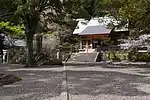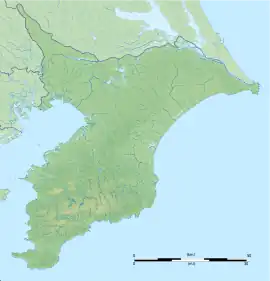| Awa Jinja 安房神社 | |
|---|---|
 Precincts of Awa Jinja
| |
| Religion | |
| Affiliation | Shinto |
| Deity | Ame-no-Futodama |
| Festival | August 10 |
| Location | |
| Location | 589 Daijngū, Tateyama, Chiba 294-0233 |
 Shown within Chiba Prefecture  Awa Shrine (Japan) | |
| Geographic coordinates | 34°55′20.80″N 139°50′12.25″E / 34.9224444°N 139.8367361°E |
| Website | |
| Official website | |
Awa Shrine (安房神社, Awa Jinja) is a Shinto shrine in the Daijingū neighborhood of the city of Tateyama in Chiba Prefecture, Japan. It is one of two shrines claiming to hold the title of ichinomiya of former Awa Province. The main festival of the shrine is held annually on August 10.[1]
Enshrined kami
The primary kami enshrined at Awa Jinja is:
- Ame-no-Futodama-no-mikoto (天太玉命), the ancestor of Imbe clan
The secondary kami enshrined at Awa Jinja are:
- Ame-no-hiritome-no-mikoto (天乃比理刀咩命), consort of Ame-no-Futodama
- Kushiakarutama-no-mikoto (櫛明玉命), ancestor of the Izumo Imbe clan, the creator of Yasakani no Magatama
- Ame-no-hiwashi-no-mikoto (天日鷲命), ancestor of the Awa Imbe clan
- Taokihooi-no-mikoto (手置帆負命), ancestor of the Saga Imbe clan
- Hikosashiri-no-mikoto (彦狭知命),, ancestor of the Kii Imbe clan
- Ame-no-mahitotsu-no-mikoto (天目一箇命), ancestor of the Tsukushi and Ise Imbe clans
History
The date of Awa Shrine’s foundation is unknown. Shrine tradition and the Kogo Shūi records of 807 AD gives the founder as a member of the Inbe clan, (the precursors to the Nakatomi clan) during the reign of the legendary Emperor Jimmu, who settled in this area from Awa Province in Shikoku. The shrine is mentioned several times in the early Heian period Rikkokushi and it is mentioned again in the Engishiki records. It was patronized by Minamoto no Yoritomo in the Kamakura period and was recognized as the ichinomiya of the province since around this time. The shrine was completely destroyed by a large earthquake in 1499, and was rebuilt in 1593 by Satomi Yoshinari. The Satomi clan rebuilt the shrine again in 1536 and around 1592. Subsequently, in the Edo Period it was granted stipends from the Tokugawa shogunate in 1616 and 1637. After the Meiji Restoration, the Awa Jinja was designated the rank of Imperial shrine, 1st rank (国幣大社, Kokuhei Taisha) under the Modern system of ranked Shinto Shrines under State Shinto in 1875.[2] The present Honden dates from 1881 and was renovated in 2009.[3]
During archaeological investigations in 1931, numerous Jōmon and Kofun period artifacts were recovered, including a number of bronze mirrors, clay vessels and the skeletons of 22 people.[4]
The shrine is a ten-kilometer walk from ateyama Station on the JR East Uchibo Line.[5]
Gallery
 Shaden
Shaden Honden
Honden Ichi-no-torii
Ichi-no-torii Precincts
Precincts Shinen-jo
Shinen-jo Imbe-zuka
Imbe-zuka Ni-no-Torii
Ni-no-Torii
See also
Notes
- ↑ Shibuya, Nobuhiro (2015). Shokoku jinja Ichinomiya Ninomiya San'nomiya (in Japanese). Yamakawa shuppansha. ISBN 978-4634150867.
- ↑ Ponsonby-Fane, Richard. (1959). The Imperial House of Japan, pp. 125.
- ↑ Yoshiki, Emi (2007). Zenkoku 'Ichinomiya' tettei gaido (in Japanese). PHP Institute. ISBN 978-4569669304.
- ↑ "安房神社洞窟遺跡" [Abo Shrine Cave Ruins] (in Japanese). Chiba Prefecture. Retrieved August 20, 2020.
- ↑ Okada, Shoji (2014). Taiyō no chizuchō 24 zenkoku 'Ichinomiya' meguri (in Japanese). Heibonsha. ISBN 978-4582945614.
External links
 Media related to Awa-jinja at Wikimedia Commons
Media related to Awa-jinja at Wikimedia Commons- Official website
References
- Plutschow, Herbe. (1996). Matsuri: The Festivals of Japan. London: RoutledgeCurzon. ISBN 1-873410-63-8
- Ponsonby-Fane, Richard Arthur Brabazon. (1959). The Imperial House of Japan. Kyoto: Ponsonby Memorial Society. OCLC 194887